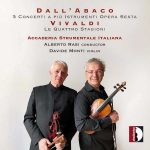
Composer: Jean Philippe Rameau
Performer: Alberto Rasi, Accademia Strumentale Italiana
Format: FLAC (tracks)
Label: Challenge Classics
Catalogue: CC72905
Release: 2022
Size: 397 MB
Recovery: +3%
Scan: yes
Premiére Concert, RCT 7
01. I. La Coulicam, Rondement
02. II. La Livri, Rondeau gracieux
03. III. Le Vézinet, Gaiement, sans vitesse
Second Concert, RCT 8
04. I. La Laborde, Rondement
05. II. La Boucon, Air, gracieux
06. III. L’Agaçante, Rondement
07. IV. Premier et 2.me Menuet
Troisième Concert, RCT 9
08. I. La La Popliniére, Rondement
09. II. La Timide, I et II Rondeau gracieux
10. III. I Tambourin et II Tambourin en rondeau
Quatrième Concert, RCT 10
11. I. La Pantomime, Loure un peu vive
12. II. L’Indiscrète, Vivement
13. III. La Rameau
Cinquième Concert, RCT 11
14. I. La Forqueray, Fugue
15. II. La Cupis, Rondement
16. III. La Marais
Fifteen years after his Nouvelles Suites de Pièces de clavecin, Rameau once again turns his attention to an instrumental work, for what will be the last time, inspired by the new potential for chamber music glimpsed in the use of the concertante keyboard. The 1741 collection is the only new work he produced between 1740 and 1744, before returning to the musical theatre – to which he will dedicate the rest of his life.
The most attractive aspect of the Pièces de clavecin en concerts, and the one which provides the most authentic reading of the work, is the multiplicity of possible combinations in performance between the instruments indicated in the score (harpsichord, violin/flute, viola da gamba/2nd violin), following the detailed instructions that Rameau provides for each of them in the various “Avis” in the preface of the printed edition. The author’s intention was undoubtedly for the harpsichord and its virtuosic protagonism to be the backbone of the Pièces; however, the possibilities of alternative timbric arrangements are specifically contemplated by Rameau for this work. What was a widespread ad libitum performance practice, today becomes an extremely inviting challenge for modern performers in terms of tonal reinvention of the pieces. Thus, with each new reading the music may be reinvented, making in turn every new listening experience a rediscovery and a revelation.



